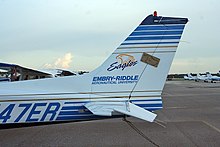Rudder lock


A rudder lock ( Gust Lock ) on an aircraft is a mechanism that locks the control surfaces while the aircraft is parked inoperative on the ground. It prevents wind from causing unexpected movement of the controls and their associated controls on the aircraft. Otherwise, gusts of wind could cause damage to control surfaces and systems or to nearby people, cargo or machinery. Some rudder locks are external devices that attach directly to the aircraft's control surfaces, while others attach to the flight controls inside the cockpit.
Similar locking
Locks for protection against the effects of wind, also called gust locks , also block the aircraft doors of some aircraft types in order to prevent mechanical damage or personal injury.
hazards
Rudder locks can be a serious risk if not removed before an aircraft takes off as they render flight controls inoperable. Many internal rudder locks will therefore also lock the aircraft's throttle or engine starters as long as they are activated. External rudder locks must be marked with a large red "Remove Before Flight" mark .
Accidents caused by rudder locks not removed
- On October 30, 1935, the first example of the Boeing B-17 Flying Fortress , the first series of the type 299, crashed when the rudder locks were locked; the two test pilots died.
- On June 3, 1936, barely a year later, the German Air Force Lieutenant General Walther Wever lost his life in a similar accident when his Heinkel He 70 lightning bolt crashed.
- On January 26, 1947, Prince Gustaf Adolf of Sweden , the American singer and actress Grace Moore and 21 other people died in the crash of a Douglas DC-3 of the Dutch KLM ( aircraft registration number PH-TCR ) at Copenhagen Airport because an auxiliary mechanic from KLM carried out the removal failed to lock the rudder locks on the aircraft's tail fin and the flight crew forgot to check the controls. (see Kastrup plane disaster ) .
- On May 29, 1947, a United Air Lines DC-4 (NC30046) rolled out of the airport premises at New York-La Guardia Airport when the take-off was delayed and exploded. The rudder locks had not been released. Only 5 of the 48 inmates survived.
- On December 20, 1952, a Douglas C-124A Globemaster II (50-0100) overturned and caught fire while taking off from Larson Air Force Base , Moses Lake , Washington . The rudder locks on the elevator and rudder had not been deactivated before take-off, so that the machine could not be steered. Of the 115 people on board, 87 died and only 28 survived.
- On December 13, 1977, an Air Indiana Douglas DC-3 (N51071) crashed shortly after take-off at Evansville Regional Airport in Evansville (Indiana) for this reason.
- On July 31, 1979 a Hawker Siddeley 748 Series 1 of Dan-Air (G-BEKF) did not take off when attempting to take off at Sumburgh Airport on the Shetland Islands and fell 50 m behind the coast into the neighboring sea after the rudder locks during the Takeoffs had been activated again and the aircraft could not gain altitude as a result. 17 of the 47 people on board were killed.
- On October 8, 2019, a BAe Jetstream 32 operated by AIS Airlines came off the runway during take-off at Münster / Osnabrück Airport . The reason for this was the rudder lock that was not removed before take-off. No people were injured. There was slight damage to the aircraft.
Individual evidence
- ↑ Air-Britain Archive: Casualty compendium part 45 (English), June 1992, p. 53.
- ^ Accident report DC-3 PH-TCR , Aviation Safety Network (English), accessed on November 23, 2017.
- ↑ accident report DC-4 NC30046 , Aviation Safety Network (English), accessed November 29, 2015.
- ↑ accident report C-124A 50-0100 , Aviation Safety Network (English), accessed October 24, 2015.
- ↑ accident report DC-3 N51071 , Aviation Safety Network (English), accessed on 25 November 2017th
- ^ Accident report HS-748 G-BEKF , Aviation Safety Network (English), accessed on January 21, 2016.
- ^ BFU interim report. Retrieved January 7, 2020 .